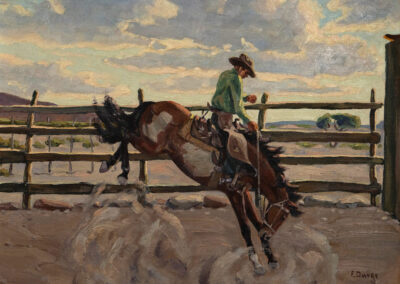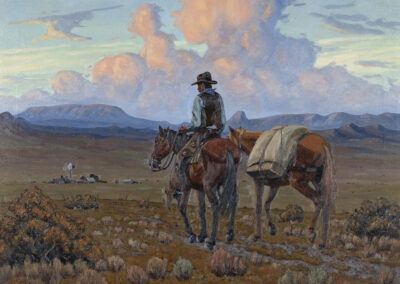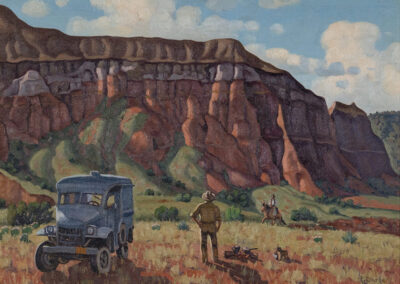The Mr. & Mrs. Robert E. McKee III Family Fred Darge Collection

Scroll down to see more artwork.
Finding Fred Darge
Bonnie and Robert E. McKee, III
Art of the Southwest and Texas was of interest when we began the adventure of collecting, but it was not until our daughter’s 1998 happenstance acquisition of two small Fred Darge oils that we became seriously interested in his art. As we began to delve into learning about this artist of whom we knew only by his name, we discovered there was almost no useful biographical information. Basic and minimal information was gathered from a few collectors and gallery owners, but was mostly inaccurate.
In May 2017, we decided to undertake the project of writing Fred’s story, emphasizing his art. Intensive research resulted in more information about his activities as a Texas artist than his life. Archives produced articles reporting on exhibits and his annual painting excursions to the Big Bend, a few of Darge’s handwritten notes shared by collector Bill Cheek, and documents from museums. A highlight was meeting and interviewing people who knew him and generously shared insights into Fred Darge, the artist who loved the Big Bend.
As collectors with an interest in history, we tremendously enjoy knowing the details of an artist’s paintings, including locations and description of activities. Darge became a chronicler of a lifeway that he knew was quickly disappearing. For us, knowing about early life in the wilds of Texas and learning about Darge’s dedication adds great interest to his paintings.
The free e-book, Fred Darge Paints the Big Bend and Beyond is available at www.freddarge.com.
The hardbound, full color catalogue, Fred Darge Paints the Big Bend and Beyond is available at the Museum of the Big Bend’s Gift Shop.
Fred Darge (1900-1978)
Friedrich Ernst (Fred) Darge was born in Rendsburg, Germany, March 1, 1900. He entered the U.S. at Port Arthur, Texas in 1923. By 1924 he was in Chicago painting and attending the Art Institute of Chicago (1925-27, 1929) and at the Arts Students League in New York. While in Chicago, Darge painted, made model sailboats, which was an interest he acquired in the German Merchant Marine at the age of 16. During this period, he made a painting trip with his wife and son through Minnesota and the Dakota’s.
By July of 1933 he had separated from his wife and son in Chicago and had settled in San Antonio as a Starving Artist. In 1935 he moved to Dallas where he finished his paintings during the winter months and spent the summers painting and sketching on ranches in West Texas, mostly the area between the Davis Mountains and the Rio Grande and in New Mexico. Darge stated “I believe the simple, direct living of the pioneer people will soon come to an end. I want to register the ranchman as he lives today, his daily habits, his mode of living and doing business.”
He soon learned to follow the life of the hands on the ranches he visited and became adept at riding and roping and made himself handy around the campfires.
Darge entered the Army in 1942 and served in the South Pacific and was honorably discharged in March 1944. He worked for North American Aviation (defense industry) as a technical illustrator until wars end.
Darge returned to Dallas in 1946 and bought a W.W.II ambulance and converted it into an artists studio/van and spent the years 1946 to 1978 traveling and painting throughout New Mexico and Texas and then returning to Dallas to finish his paintings, carve, build and sail his model boats.
His paintings have been exhibited in Chicago (Union League Club/Art Institute of Chicago); New York (Art Students League); Miami, Philadelphia, Dallas (Museum of Fine Arts/Texas Centennial Exposition); San Antonio (Witte Museum); Fort Worth (Annual Texas Artists Exposition); Corpus Christi, Austin (Laguna Gloria Art Museum); Taos and Santa Fe, New Mexico and others, winning numerous awards and honorable mentions.
His later years were spent at his studio adjacent to the Dallas Art Association where he also acted as an instructor. He died in Dallas.










